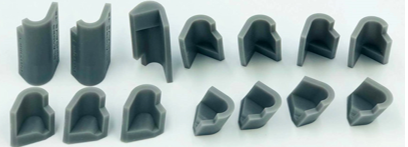A common question I hear from my customers is, "What 3D materials are tough and which materials are best suited for certain applications?" The second question I typically hear is, "What is the print speed?" While not many new AM technologies are being developed, the same is not true with materials. With innovations in 3D printing and materials development, entirely new business models are being unlocked. 3D printing is developing fast. With ever-evolving technologies and materials, the range of addressable applications across industries has never been so varied or offered such huge opportunities. No material can do everything.
The 3D Systems' Figure 4 DLP technology has been especially transformative. Innovative new materials open up new production workflows for digital manufacturing. Plastic printing materials are particularly versatile. Listed below are industrial materials and applications applicable to the Figure 4 DLP technology. These materials are a new class of additive materials with industry-leading UV stability.
Figure 4® Rigid 140C Black, Figure 4® Rigid White, Figure 4® Rigid Gray, Figure 4® Tough 60C White, Figure 4® Tough 65C Black, Figure 4® PRO-BLK 10: True production-class material; versatile rigid urethane-like material with an industry-leading combination of speed, accuracy and engineering-grade properties of strength, impact, and heat resistance.
GOOD FOR: • Rapid prototyping • Functional assemblies • Snap-fit components • Consumer electronic components • Drill/tap applications • Master patterns for vacuum casting
Figure 4® 150C FR Black:
GOOD FOR: • Aircraft interior parts • Consumer goods and electronics • Components requiring flame retardancy
Figure 4® FLEX-BLK 20 and Figure 4® FLEX-BLK 10: Extremely durable polypropylene-like parts Highest precision prototyping material with UV stability for production applications where mechanical properties fit.
GOOD FOR: • Prototyping • Functional testing • Low-volume production • Master patterns for RTV/silicone molding • Snap-fit assemblies
Figure 4® HI TEMP 300-AMB: High-temperature resistance for use in the harshest environments.
GOOD FOR: • HVAC, consumer appliances, motor enclosures, and other test or end-use components requiring high heat resistance • Low-pressure molding/tooling • Overmolding
Figure 4® RUBBER-BLK 10 and Figure 4® Rubber 65A BLK: High tear strength, malleable material for hard, rubber-like parts.
GOOD FOR: • Functional prototypes with rubber-like properties - Gaskets - Hoses - Seals • Low to mid-volume direct manufacturing of end-use parts • Strain-relief applications
Figure 4® MED-AMB 10 and Figure 4® MED-WHT 10: Materials with biocompatibility and autoclave stability for medical and industrial.
GOOD FOR: • Medical applications, including - Surgical drill guides - Splints - Anatomical or bone models • High-temperature applications
Figure 4® EGGSHELL-AMB 10: A rigid plastic for casting silicones to withstand injection at high temperature and pressure, but easy to break away.
GOOD FOR: • Silicone castings • Customized end-use silicone parts • Low-volume production of silicone parts
With a better understanding of industrial materials discussed for the 3D Systems' Figure 4 DLP technology, I want to discuss the advancements in print speed. Figure 4 offers ultra-high print speeds with 3 print modes, enabling up to 100mm/hour printing, some of the faster on the 3D printer market today. The following is a good example from a service bureau printing aerospace check fixtures. 
- CHALLENGE: Deliver production-grade check fixtures for aerospace customer with a very fast turnaround.
- SOLUTION: Figure 4 with 3D Sprint software and Figure 4 TOUGH-GRY 15 material.
- RESULTS:
- 24 parts printed per tray
- Print set up time - 7 minutes
- Time to part in-hand - 91 minutes
- Print time - 31 minutes
- Post-processing - 60 minutes
To round out the key advancements of the 3D Systems' Figure 4, alongside the materials science and production-grade end-use parts at accelerated speeds, the new high-density part stacking feature of 3D Systems' 3D Sprint software allows efficient part nesting and optimized support generation to enable new efficiency in batch printing and post-processing. Advantages of High-Density Vertical Stacked Printing over traditional methods 3D printing often leads to fast turnaround times without using expensive tooling. Additive Manufacturing, AM serves as a great tool for prototyping and low/mid-sized production by using high-density vertical stacked printing. Key drivers for stacked printing include:
- Productivity and Efficiency: by utilizing the full build height (350 mm) and stacking parts, more parts can be printed. With 3D Systems' additive manufacturing workflow software, 3D Sprint, stacks can be easily generated and supported to maximize packing density, reduce post-processing, and decrease labor times.
- Strut Array Generation: Quickly generate and replicate strut supports throughout a stack within 3D Sprint. The open, sparse strut network maximizes solvent washing, air drying, and post-cure process effectiveness for batch manufacturing.
- Overnight Printing and Cadence: For manufacturers that do not work around the clock, there is a lot of wasted time at night that could be used for printing parts. Prints can be planned more efficiently to improve throughput in a single day by printing less frequently, but with a larger yield. If build times are too short, technicians would get overwhelmed from replacing builds for many printers.
- Automation Compatible: Another method for improving the efficiency of the entire workflow is by using automation. With pinpoint contact strut supports allowing for quick removal of supports, automation can be used to clean, dry, and cure stacks of parts without human labor. Multiple wash stations can be used for cleaning parts.
If you want to know more about the advancements of vertical stacking with the 3D Systems solutions please click the following: 3D Systems Application Brief - Industrial Stacking
If you want more information in general, feel free to visit us at www.mastergraphics.com or contact me directly at barb.miller-webb@mastergraphics.com


